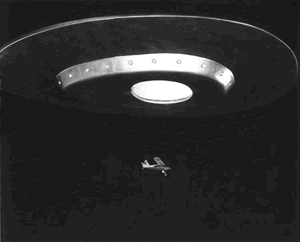 |
Saucer abducts airplane
This Island Earth, © Universal Studios 1955 |
The Kinross Incident
Did a UFO abduct an Air Force jet interceptor and its crew in 1953?
Donald Keyhoe - UFO researcher, ex-Marine and director of the National Investigations Committee on Aerial Phenomena (NICAP) - an early advocate of the concept that UFOs were extraterrestrial spacecraft visiting Earth on reconnaissance and sampling missons, was particularly intrigued with cases where aircraft interacted with the objects. He was especially fascinated with one 1953 case, describing it in several articles and books. Here is one of the most detailed versions:
One of the strangest cases on record occurred in 1953. Though it has received considerable publicity, some of the follow-up developments are not generally known. On the night of November 23, 1953, an F-89 all-weather interceptor was scrambled at Kinross AFB, to check on a UFO flying over the Soo Locks. The jet had a crew of two – Lt. Felix Moncla, the pilot, and Lt. R. R. Wilson, the radar observer. Guided by an AF GCI (Ground Control Intercept) radar station, Moncla followed the unknown machine out over Lake Superior, flying at 500 miles an hour. Minutes later, a GCI controller was startled to see the blips of the jet and the UFO suddenly merge on the radar-scope. Whatever had happened, one thing was certain: The F-89 and the UFO were locked together. As the combined blip went off the scope the controller hurriedly radioed Search and Rescue. Moncla and Wilson might have bailed out before the collision. Both had life jackets and self-inflating life rafts – even in the cold water they could survive for a while. All night, U.S. and Canadian search planes with flares circled low over the area. At daylight, a score of boats joined the hunt, as the pilots crisscrossed the lake for a hundred miles. But no trace was found of the airmen, the jet or the UFO. The search was still on when Truax AFB gave the Associated Press this official release: “The plane was followed by radar until it merged with an object 70 miles off Keweenaw Point in upper Michigan.” In view of AF secrecy this was a surprising admission. The statement appeared in an early edition of the Chicago Tribune, headed JET, TWO ABOARD, VANISHES OVER LAKE SUPERIOR. (Photocopy in author's possession.) Then AF Headquarters killed the story. Denying the jet had merged with anything, the AF said that radar operators had misread the scope. The reported UFO, it stated, had been an offcourse Canadian airliner which the F-89 had intercepted and identified. After this, the AF speculated, the pilot evidently had been stricken with vertigo and the jet had crashed in the lake. The Canadian airlines quickly denied any flights in the area. Expert pilots also hit at the AF explanation. As customary, the AF sent two officers to the families of the lost airmen to give them official messages of sympathy. According to letters which a relative of Moncla sent me, here is what followed. Explaining the accident, the AF representative told Moncla's widow that the pilot had flown too low while identifying the supposed Canadian airliner and had crashed in the lake. By some headquarters mixup, a second AF officer was sent to offer condolences to the Moncla family. When Moncla's widow asked if her husband's body might be recovered the officer said there was no chance the jet had exploded at a high altitude, destroying the plane and its occupants.
- Aliens From Space (1973)
Official Accounts
The following official accounts of the Kinross loss were obtained by Robert Todd under the Freedom of Information Act. Note that, surprisingly enough, there were two F-89s lost by the 433d Fighter Interceptor Squadron on November 23, 1953 - the first while returning from a short engine test flight near the 433d's home base at Truax AFB, Madison, Wisconsin, and the second on an operational intercept mission over Lake Superior, originating from Kinross AFB, Michigan, a satellite base of Truax. All four crewmen were either killed outright or declared missing and listed as dead.
A crucial point is that the first entry clearly implies that the unidentified radar target that Moncla was pursuing when his fighter disappeared was in radio contact with ground controllers at some point, and therefore was not a UFO: "the bogey was not aware of any aircraft in the area."
CHAPTER III OPERATIONS AND TRAINING
On 23 November a F-89 assigned to the 433d took off on a routine operational flight to check the afterburners on the new J-35-A-47 engines. After climbing to 40,000 feet and broadcasting performance data to the ground recording unit, air-to-ground transmission was discontinued. Approximately twelve minutes after the last transmission was received the ship crashed and disintegrated upon impact, killing both crew members. Prior to the crash, the aircraft was observed to pull out of a steep dive and eject the canopy. Cause was undetermined. Still again in November, an F-89 of Detachment #1, Kinross AFB, Michigan, took off on an active Air Defense mission and disappeared. GCI had control of the fighter and was directing it from 25,000 feet down to 7,000 feet. The fighter and bogey blips merged on the GCI radar scope and there was no further transmission from the fighter. The bogey was not aware of any aircraft in the area, and GCI saw no blips break off from the target. Both pilot and observer are missing and officially listed as dead.
HISTORICAL DATA FOR THE 433d FIGHTER INTERCEPTOR SQUADRON 1 July 1953-31 December 1953
D. Accidents On 23 November 1953, an F-89C assigned to this organization took off from Truax Field on a routine operational check of the afterburners on the J-35-A-47 engines. The pilot climbed to 40,000 feet and at the same time broadcast performance data to a ground recording unit. After reaching 40,000 feet, air to ground transmission was discontinued as all data had been received. Approximately twelve minutes after the last transmission the aircraft crashed seven miles south of the field with injuries fatal to both crew members. The aircraft was observed to have pulled out of a steep dive at 500 feet, and the canopy was ejected just prior to impact. On 23 November 1953, an F-89C of Detachment #1, 433d Fighter-Interceptor Squadron, Kinross Air Force Base, Michigan, took off on an active air defense mission. GCI had control of the fighter and was directing it from 25,000 feet down to 7,000 feet. The fighter and the bogey blips merged on the GCI radar scope. There was no further transmission from the fighter, the bogey was not aware of any aircraft in the area, and GCI saw no blips break off from the target. Both pilot and radar observer are missing and are now officially listed as dead.
OPERATIONS
In November this unit had a jet fighter, an F-89C type aircraft disappear over Lake Superior while on an active air defense mission under this unit’s control. The Controller (4) [2nd Lt. Douglas A. Stuart] on duty had positioned the fighter for the final phase of the intercept and the blips merged on the scope. Radar and radio [contact] was lost with the F-89 at this time and the aircraft was never sighted again. The search for the missing aircraft was under the direction of the Canadian Air Force; and the United States Coast Guard, Air Force, and Canadian Air Force participated in the search. No trace was found of the plane and crew of two.
The Events of November 23, 1953
 |
F-98C 51-5855 of 433d Fighter Interceptor Squadron - the second-last F-89C built. The aircraft involved in the Kinross incident was nearly identical, built just two slots ahead on the Northrop assembly line. |
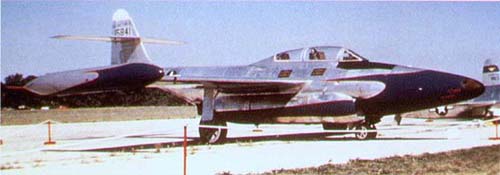 |
A color photo of another 433d FIS F-89C, showing the squadron's "Blue Streak" markings |
The 433d Fighter Interceptor Squadron was based at Truax AFB, Madison, Wisconsin, and flew Northrop F-98C Scorpion all-weather jet interceptors, which were the first US jet fighter specifically designed to carry radar and operate in night or bad-weather conditions. The F-89 had suffered serious development problems, including a fleet-wide grounding in late 1952. At the time of the incidents, less than 40 were permitted by Air Defense Command to stand alert on operational ADC missions.
See: The Troubled F-89
Around 12:30 on the afternoon of Monday, November 23, 1953, an F-89C took off from Truax AFB for a short flight. At its controls was 1st Lt. John W. Schmidt, 28, of Del Rio, Texas. In the rear seat was Capt. Glen E. Collins, 30, from Indianapolis, Indiana. Both men were experienced veterans who had flown combat duty in the Pacific theatre during WWII.
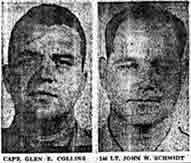
Their mission that day was a quick checkout the afterburners of newly installed engines. The fighter climbed rapidly to 40,000 feet and the engine tests were performed with no apparent problems. The men transmitted their instrument readings, signed off, and headed back toward Truax.
About ten minutes later, Mrs. Donald Alme was standing outside her home in Madison when she suddenly saw a jet overhead. "It was quite low and I knew it was a jet, but there wasn't any noise like you always hear from a jet. It was just still-like…suddenly there was something just like an explosion - oh, an awful, huge noise. The jet then plummeted to earth - just so fast your eye could hardly follow it." Another witness, who was about two miles from the crash site, said, " I heard the plane roaring across the hill and thought it was going to land in the marsh south of my house. Then it pulled up … lifted up over and headed for the arboretum. There was a puff of smoke and the plane seemed to dive right straight down. After that there was a real loud thud and I knew it had crashed."
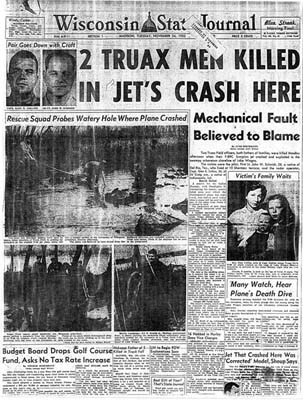 |
The first fatal 433d FIS F-89C crash on November 23, 1953
click to enlarge |
Meanwhile, Detachment 1 of the 433d FIS, which consisted of two Scorpions, was standing alert a considerable distance away at Kinross AFB, on Michigan's upper peninsula, near the locks on the Sault St Marie Canal. 1st Lt Felix E. Moncla, Jr., of Moreauville, Louisiana, and 2nd Lt. Robert L. Wilson, from Ponca City, Oklahoma, crewed aircraft 5853.
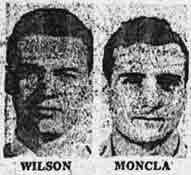
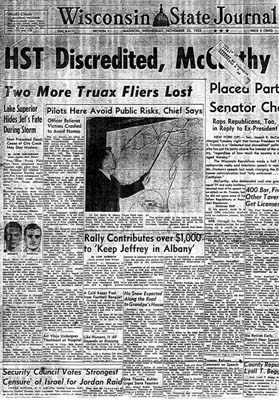 |
The second loss of November 23 - Moncla and Wilson's aircraft
click to enlarge |
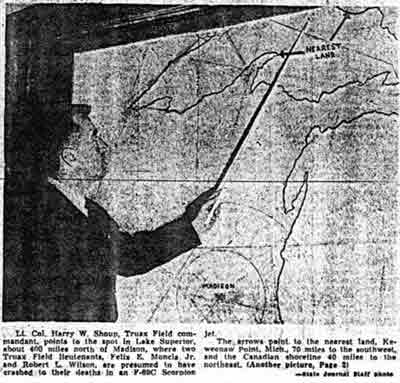 |
click for detail |
The point where the radar blips merged and the fighter disappeared was well into the Canadian side of Lake Superior. The Search and Rescue effort was handled by Canadian forces for the most part.
 |
Arrow marks approximate location of the disappearance of Moncla's F-89 |
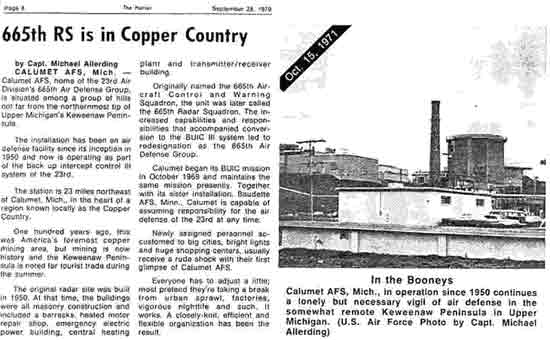 |
The Air Defense Command radar site that was tracking Moncla's plane - remote Calumet AFS, MI, near the tip of the Keweenaw peninsula which juts into Lake Superior. Radar in use was probably an AN/CPS-5 |